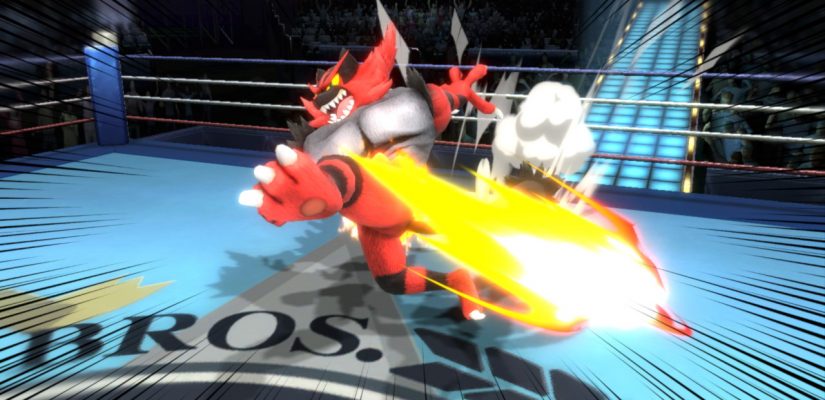Incineroar is one of my favorite characters to play in Super Smash Bros. Ultimate. He’s the first truly traditional grappler character in the franchise, and his entire moveset directly reflects the Pokémon’s pro wrestling background. However, what I think is really fascinating about Incineroar’s implementation in Smash is that the character draws most directly from an old-school Japanese professional wrestling aesthetic and history.
To start off, a major part of Incineroar’s Japan-inspired wrestling design is a part of its identity as a Pokémon. It clearly takes a lot of influence from the beloved fictional wrestling character turned actual flesh-and-blood wrestler Tiger Mask—both are cat-themed athletes who are ostensibly heels but have a soft spot for children. But if you take a look at the relative strength of Incineroar’s attacks, you’ll find that it’s based on Japan’s cultural understanding of pro wrestling.

Incineroar’s forward smash is an Enzuigiri, and it has immense damage and KO potential. To a viewer mainly familiar with American promotions, the Enzuigiri is mostly used as a transitional move to something stronger or a counter to an opponent’s offense. However, the technique has a greater legacy in Japan, where it is the finisher of Antonio Inoki, one of the three most famous Japanese wrestlers of all time. Inoki is a legend as both a champion and the founder of New Japan Pro-Wrestling, and was even used as the model for the character Fighter Hayabusa in the NES game Pro Wrestling, where the Enzuigiri is known as the “Back Brain Kick.”

If you look at what Incineroar can do off a grab, you’ll find a similar phenomenon. Of the character’s four basic throws, the deadliest one is the German Suplex. Again, you have a move that, outside of Japan, is seen as kind of generic; maybe at most, people might associate it with Kurt Angle or Brock Lesnar. But the German Suplex is also the defining hold of Karl Gotch, the man known as the “god of wrestling” in Japan. Gotch had an enormous influence on the Japanese pro wrestling style, and even today whenever a wrestler pulls off a German Suplex in Japan, it’s seen as a big deal that can potentially end a match right then and there.

Another powerful throw Incineroar uses is the Argentine Backbreaker. While this move is seen in the US as more impactful than the Enzuigiri or German Suplex thanks to wrestlers like Lex Luger and the man who originally popularized it, Antonino Rocca, its footprint is even more prevalent in Japan. Not only did Rocca wrestle in Japan later in his career and is possibly the namesake of Antonio Inoki, but the Argentine Backbreaker also gained notoriety in the pages of the manga Kinnikuman. There, the character Robin Mask (a wrestler dressed like an English knight) uses it as a finishing move, calling it the Tower Bridge. Moreover, it’s clear that at least Sakurai Masahiro (the director of the Smash Bros. franchise) knows Kinnikuman: he posted to Twitter an image of Smash characters mimicking the Muscle Docking technique from the series:

Moving on, Incineroar’s best attack is arguably its side special, the Alolan Whip. While the name itself is a parody of the Irish Whip, the more important part is the follow-up: a vicious Lariat.

One of the most famous American wrestlers to ever entertain fans in Japan is Stan Hansen, whose Western Lariat became downright iconic everywhere he fought. On the Japanese Wikipedia page for “Lariat,” the history section literally begins with a mention of Hansen, and in current times, the Japanese wrestler Okada Kazuchika is famed for his “Rainmaker” Lariat. Incidentally, Incineroar also has another related move taken from the Pokémon games—Darkest Lariat—but that’s closer to Zangief from Street Fighter II’s Double Lariat.
Generally speaking, I find that pro wrestling has a lot more of a longstanding influence on Japanese pop culture than it does American pop culture, despite the fact that pro wrestling as we know it has its origins in the United States. Even today, manga and anime wholly unrelated to wrestling or hand-to-hand combat (like Laid-Back Camp) will throw in a few references, as if to assume a common understanding among readers. So while having a wrestling cat for a Pokémon is not altogether that unusual regardless of culture, I find the execution of such a concept in Smash Bros. Ultimate to be very reflective of that enduring legacy. The fact that Incineroar so embodies the values of Japanese pro wrestling makes it all the more fun to play, win or lose.








